Information
LHCb-PAPER-2014-070
CERN-PH-EP-2015-110
arXiv:1505.01710 [PDF]
(Submitted on 07 May 2015)
Phys. Rev. D92 (2015) 032002
Inspire 1367306
Tools
Abstract
The resonant substructures of $B^0 \to \overline{D}^0 \pi^+\pi^-$ decays are studied with the Dalitz plot technique. In this study a data sample corresponding to an integrated luminosity of 3.0 fb$^{-1}$ of $pp$ collisions collected by the LHCb detector is used. The branching fraction of the $B^0 \to \overline{D}^0 \pi^+\pi^-$ decay in the region $m(\overline{D}^0\pi^{\pm})>2.1$ GeV$/c^2$ is measured to be $(8.46 \pm 0.14 \pm 0.29 \pm 0.40) \times 10^{-4}$, where the first uncertainty is statistical, the second is systematic and the last arises from the normalisation channel $B^0 \to D^*(2010)^-\pi^+$. The $\pi^+\pi^-$ S-wave components are modelled with the Isobar and K-matrix formalisms. Results of the Dalitz plot analyses using both models are presented. A resonant structure at $m(\overline{D}^0\pi^-) \approx 2.8$ GeV$/c^{2}$ is confirmed and its spin-parity is determined for the first time as $J^P = 3^-$. The branching fraction, mass and width of this structure are determined together with those of the $D^*_0(2400)^-$ and $D^*_2(2460)^-$ resonances. The branching fractions of other $B^0 \to \overline{D}^0 h^0$ decay components with $h^0 \to \pi^+\pi^-$ are also reported. Many of these branching fraction measurements are the most precise to date. The first observation of the decays $B^0 \to \overline{D}^0 f_0(500)$, $B^0 \to \overline{D}^0 f_0(980)$, $B^0 \to \overline{D}^0 \rho(1450)$, $B^0 \to D_3^*(2760)^- \pi^+$ and the first evidence of $B^0 \to \overline{D}^0 f_0(2020)$ are presented.
Figures and captions
|
Examples of tree diagrams via $\bar{b} \rightarrow \bar{c}u\bar{d}$ transition to produce (a) $\pi ^+ \pi ^- $ resonances, (b) nonresonant three-body decay and (c) $\overline{ D }{} {}^0 \pi ^- $ resonances. |
Fig1.pdf [187 KiB] HiDef png [320 KiB] Thumbnail [112 KiB] *.C file |

|
|
Invariant mass distribution of $B^0 \rightarrow \overline{ D }{} {}^0 \pi^+\pi^-$ candidates. Data points are shown in black. The fit is shown as a solid (red) line with the background component displayed as dashed (green) line. |
Fig2.pdf [21 KiB] HiDef png [173 KiB] Thumbnail [145 KiB] *.C file |

|
|
Density profile of the combinatorial background events in the Dalitz plane obtained from the upper $m(\overline{ D }{} {}^0 \pi^+\pi^-)$ sideband with a looser selection applied on the Fisher discriminant. |
Fig3.pdf [17 KiB] HiDef png [180 KiB] Thumbnail [189 KiB] *.C file |

|
|
Efficiency function for the Dalitz variables obtained in a fit to the LHCb simulated samples. |
Fig4.pdf [54 KiB] HiDef png [570 KiB] Thumbnail [179 KiB] *.C file |
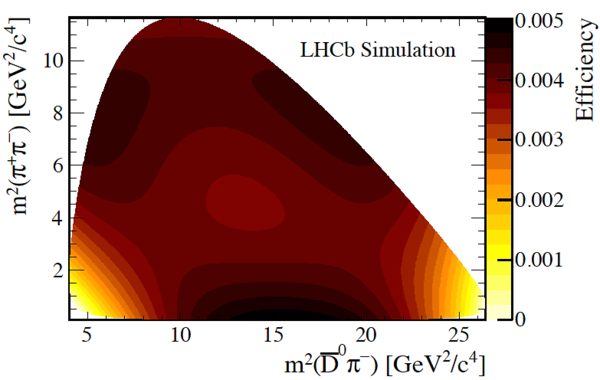
|
|
Dalitz plot distribution of candidates in the signal region, including background contributions. The red line shows the Dalitz plot kinematic boundary. |
Fig5.pdf [26 KiB] HiDef png [427 KiB] Thumbnail [322 KiB] *.C file |
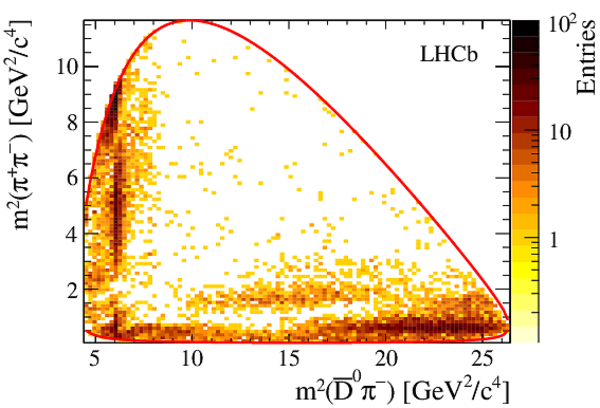
|
|
Projections of the data and Isobar fit onto (a) $m^2(\pi^+\pi^-)$ and (c) $m^2(\overline{ D }{} {}^0 \pi^-)$ with a linear scale. Same projections shown in (b) and (d) with a logarithmic scale. Components are described in the legend. The lines denoted $\overline{ D }{} {}^0 \pi^-$ and $\pi^+\pi^-$ include the coherent sums of all $\overline{ D }{} {}^0 \pi^-$ resonances, $\pi^+\pi^-$ resonances, and $\pi^+\pi^-$ S-wave resonances. The various contributions do not add linearly due to interference effects. |
Fig6a.pdf [74 KiB] HiDef png [197 KiB] Thumbnail [162 KiB] *.C file |

|
|
Fig6b.pdf [72 KiB] HiDef png [241 KiB] Thumbnail [194 KiB] *.C file |

|
|
|
Fig6c.pdf [35 KiB] HiDef png [198 KiB] Thumbnail [171 KiB] *.C file |

|
|
|
Fig6d.pdf [34 KiB] HiDef png [217 KiB] Thumbnail [173 KiB] *.C file |

|
|
|
Projections of the data and K-matrix fit onto (a) $m^2(\pi^+\pi^-)$ and (c) $m^2(\overline{ D }{} {}^0 \pi^-)$ with a linear scale. Same projections shown in (b) and (d) with a logarithmic scale. Components are described in the legend. The lines denoted $\overline{ D }{} {}^0 \pi^-$ and $\pi^+\pi^-$ include the coherent sums of all $\overline{ D }{} {}^0 \pi^-$ resonances, $\pi^+\pi^-$ resonances, and $\pi^+\pi^-$ S-wave resonances. The various contributions do not add linearly due to interference effects. |
Fig7a.pdf [76 KiB] HiDef png [197 KiB] Thumbnail [164 KiB] *.C file |
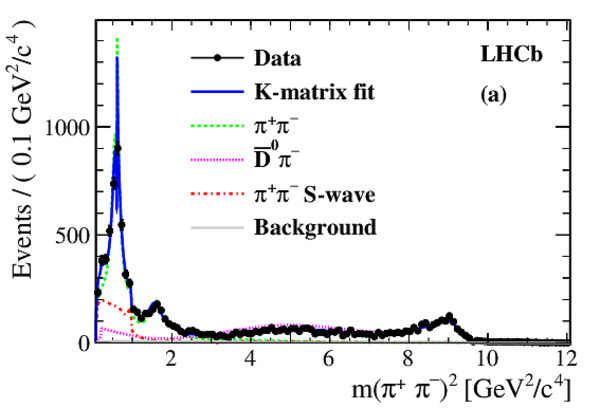
|
|
Fig7b.pdf [73 KiB] HiDef png [246 KiB] Thumbnail [196 KiB] *.C file |

|
|
|
Fig7c.pdf [35 KiB] HiDef png [200 KiB] Thumbnail [172 KiB] *.C file |

|
|
|
Fig7d.pdf [34 KiB] HiDef png [218 KiB] Thumbnail [173 KiB] *.C file |
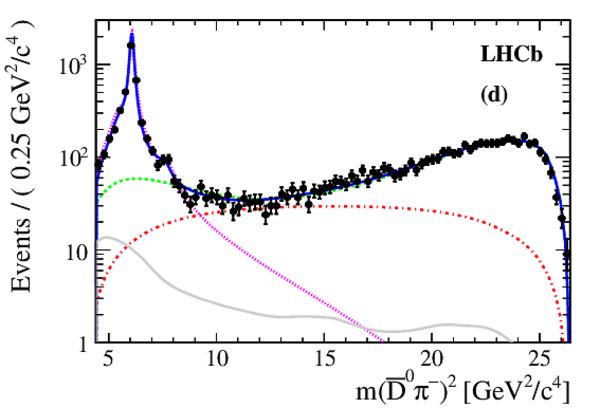
|
|
|
Comparison of the $\pi^+\pi^-$ S-wave obtained from the Isobar model and the K-matrix model, for (a) amplitudes and (b) phases. The K-matrix model is shown by the red solid line, two scenarios for the Isobar model with (black long dashed line) and without (blue dashed line) $f_0(1370)$ and $f_0(1500)$ are shown. |
Fig8a.pdf [29 KiB] HiDef png [222 KiB] Thumbnail [195 KiB] *.C file |
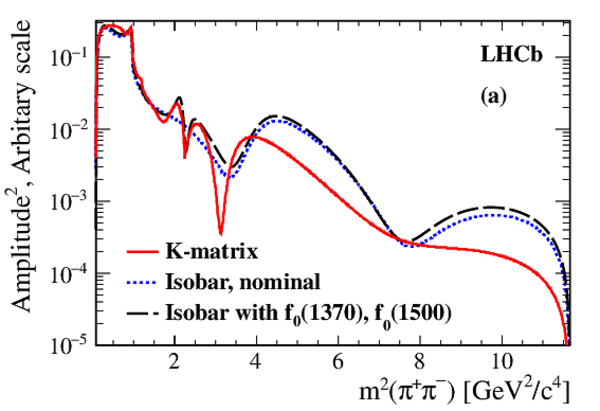
|
|
Fig8b.pdf [186 KiB] HiDef png [193 KiB] Thumbnail [163 KiB] *.C file |

|
|
|
Distributions of $m^2(\pi^+\pi^-)$ in the $\rho(770)$ mass region. The different fit components are described in the legend. Results from (a) the Isobar model and (b) the K-matrix model are shown. |
Fig9a.pdf [64 KiB] HiDef png [294 KiB] Thumbnail [237 KiB] *.C file |

|
|
Fig9b.pdf [41 KiB] HiDef png [272 KiB] Thumbnail [228 KiB] *.C file |
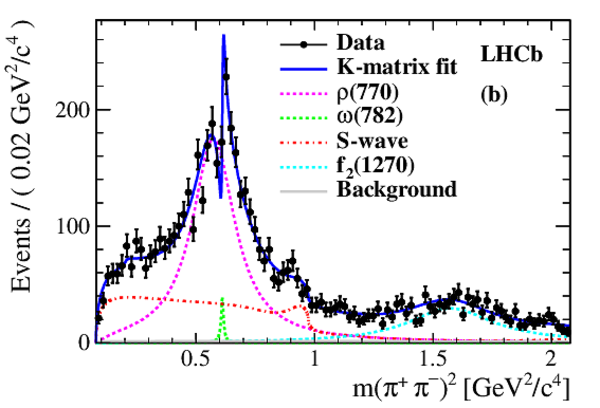
|
|
|
Distributions of $m^2(\overline{ D }{} {}^0 \pi ^- )$ in the $D_J^*(2760)^-$ mass region. The different fit components are described in the legend. Both results from (a) the Isobar model and (b) the K-matrix model are shown. |
Fig10a.pdf [28 KiB] HiDef png [237 KiB] Thumbnail [197 KiB] *.C file |

|
|
Fig10b.pdf [24 KiB] HiDef png [238 KiB] Thumbnail [198 KiB] *.C file |

|
|
|
Invariant mass distributions of (a) $m(\overline{ D }{} {}^0 \pi^+\pi^-)$ and (b) $m(\overline{ D }{} {}^0 \pi^-)$ for $B^0 \rightarrow D^*(2010)^-\pi^+$ candidates. The data is shown as black points with the fit superimposed as red solid lines. |
Fig11a.pdf [21 KiB] HiDef png [277 KiB] Thumbnail [255 KiB] *.C file |

|
|
Cosine of the helicity angle distributions in the $m^2(\overline{ D }{} {}^0 \pi^-)$ range [7.4, 8.2] GeV$^2/c^4$ for (a) the Isobar model and (b) the K-matrix model. The data are shown as black points. The helicity angle distributions of the Dalitz plot fit results, without the $D^*_J(2760)^-$ and with the different spin hypotheses of $D^*_J(2760)^-$, are superimposed. |
Fig12a.pdf [25 KiB] HiDef png [297 KiB] Thumbnail [227 KiB] *.C file |

|
|
Fig12b.pdf [26 KiB] HiDef png [300 KiB] Thumbnail [226 KiB] *.C file |
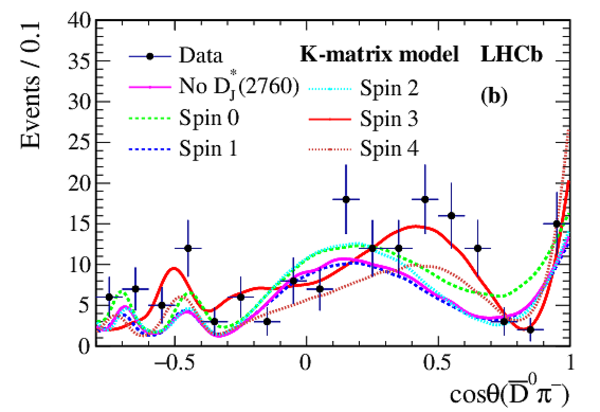
|
|
|
Mixing angle as a function of form factor ratio for the (a) $q\bar{q}$ model and (b) $[qq'][\bar{q}\bar{q'}]$ tetraquark model. Green band gives 1$\sigma$ interval around central values (black solid line). |
Fig13a.pdf [26 KiB] HiDef png [116 KiB] Thumbnail [101 KiB] *.C file |

|
|
Fig13b.pdf [37 KiB] HiDef png [143 KiB] Thumbnail [117 KiB] *.C file |

|
|
|
The first eight unnormalised Legendre polynomial weighted moments (0 to 7 correspond to (a) to (h)) for background-subtracted and efficiency-corrected $B^0 \rightarrow \overline{ D }{} {}^0 \pi^+\pi^-$ data and the Dalitz plot fit results as a function of $m^2(\overline{ D }{} {}^0 \pi^-)$. |
Fig14.pdf [78 KiB] HiDef png [720 KiB] Thumbnail [515 KiB] *.C file |
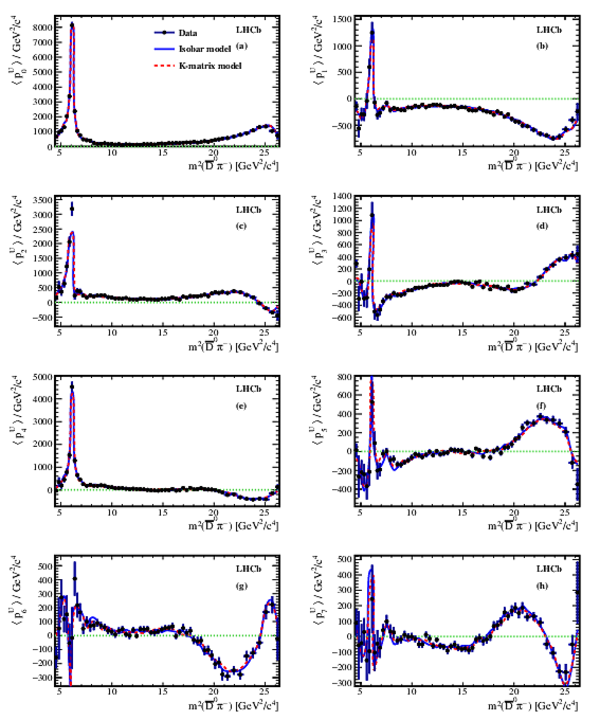
|
|
The first eight unnormalised Legendre polynomial weighted moments (0 to 7 correspond to (a) to (h)) for background-subtracted and efficiency-corrected $B^0 \rightarrow \overline{ D }{} {}^0 \pi^+\pi^-$ data and the Dalitz plot fit results as a function of $m^2(\pi^+\pi^-)$. |
Fig15.pdf [71 KiB] HiDef png [643 KiB] Thumbnail [464 KiB] *.C file |

|
|
The first eight unnormalised Legendre polynomial weighted moments (0 to 7 correspond to (a) to (h)) for background-subtracted and efficiency-corrected $B^0 \rightarrow \overline{ D }{} {}^0 \pi^+\pi^-$ data and the Dalitz plot fit results as a function of $m^2(\overline{ D }{} {}^0 \pi^-)$. Only results in the region $m^2(\overline{ D }{} {}^0 \pi^-)< 10$ GeV$^2$/$c^4$ are shown. |
Fig16.pdf [198 KiB] HiDef png [763 KiB] Thumbnail [535 KiB] *.C file |

|
|
The first eight unnormalised Legendre polynomial weighted moments (0 to 7 correspond to (a) to (h)) for background-subtracted and efficiency-corrected $B^0 \rightarrow \overline{ D }{} {}^0 \pi^+\pi^-$ data and the Dalitz plot fit results as a function of $m^2(\pi^+\pi^-)$. Only results in the region $m^2(\pi^+\pi^-)< 3$ GeV$^2$/$c^4$ are shown. |
Fig17.pdf [202 KiB] HiDef png [759 KiB] Thumbnail [539 KiB] *.C file |

|
|
Animated gif made out of all figures. |
PAPER-2014-070.gif Thumbnail |

|
Tables and captions
|
Results of the fit to the invariant mass distribution of $B^0 \rightarrow \overline{ D }{} {}^0 \pi^+\pi^-$ candidates. Uncertainties are statistical only. |
Table_1.pdf [59 KiB] HiDef png [70 KiB] Thumbnail [33 KiB] tex code |

|
|
The K-matrix parameters used in this paper are taken from a global analysis of $\pi^+\pi^-$ scattering data [22]. Masses and coupling constants are in units of $ {\mathrm{ Ge V /}c^2}$ . |
Table_2.pdf [58 KiB] HiDef png [105 KiB] Thumbnail [46 KiB] tex code |

|
|
Resonant contributions to the nominal fit models and their properties. Parameters and uncertainties of $\rho(770)$, $\omega(782)$, $\rho(1450)$ and $\rho(1700)$ come from Ref. [92], and those of $f_2(1270)$ and $f_0(2020)$ come from Ref. [32]. Parameters of $f_0(500)$, $f_0(980)$ and K-matrix formalism are described in Sec. 4. |
Table_3.pdf [57 KiB] HiDef png [125 KiB] Thumbnail [59 KiB] tex code |

|
|
Systematic uncertainties on $\cal B ( B ^0 \rightarrow \overline{ D }{} {}^0 \pi ^+ \pi ^- )$. |
Table_4.pdf [45 KiB] HiDef png [62 KiB] Thumbnail [28 KiB] tex code |

|
|
Statistical significance ($\sigma$) of $\pi^+\pi^-$ resonances in the Dalitz plot analysis. For the statistically significant resonances, the effect of adding dominant systematic uncertainties is shown (see text). |
Table_5.pdf [36 KiB] HiDef png [29 KiB] Thumbnail [13 KiB] tex code |

|
|
Measured masses ($m$ in $ {\mathrm{ Me V /}c^2}$ ) and widths ($\Gamma$ in $\mathrm{ Me V}$ ) of the $D_0^*(2400)^-$, $D_2^*(2460)^-$ and $D_3^*(2760)^-$ resonances, where the first uncertainty is statistical, the second and the third are experimental and model-dependent systematic uncertainties, respectively. |
Table_6.pdf [43 KiB] HiDef png [58 KiB] Thumbnail [30 KiB] tex code |

|
|
The moduli of the complex coefficients of the resonant contributions for the Isobar model and the K-matrix model. The first uncertainty is statistical, the second and the third are experimental and model-dependent systematic uncertainties, respectively. |
Table_7.pdf [54 KiB] HiDef png [131 KiB] Thumbnail [61 KiB] tex code |

|
|
The phase of the complex coefficients of the resonant contributions for the Isobar model and the K-matrix model. The first uncertainty is statistical, the second and the third are experimental and model-dependent systematic uncertainties, respectively. |
Table_8.pdf [54 KiB] HiDef png [130 KiB] Thumbnail [66 KiB] tex code |

|
|
The fit fractions of the resonant contributions for the Isobar and K-matrix models with $m(\overline{ D }{} {}^0 \pi^{\pm})> 2.1$ $ {\mathrm{ Ge V /}c^2}$ . The first uncertainty is statistical, the second and the third are experimental and model-dependent systematic uncertainties, respectively. |
Table_9.pdf [54 KiB] HiDef png [160 KiB] Thumbnail [79 KiB] tex code |

|
|
Correction factors due to the $D^*(2010)^-$ veto. |
Table_10.pdf [52 KiB] HiDef png [303 KiB] Thumbnail [117 KiB] tex code |

|
|
Measured branching fractions of $\cal B ( B ^0 \rightarrow r h_3) \times \cal B (r \rightarrow h_1 h_2)$ for the Isobar and K-matrix models. The first uncertainty is statistical, the second the experimental systematic, the third the model-dependent systematic, and the fourth the uncertainty from the normalisation $B^0 \rightarrow D^*(2010)^- \pi^+$ channel. |
Table_11.pdf [45 KiB] HiDef png [126 KiB] Thumbnail [62 KiB] tex code |

|
|
Systematic uncertainties on $r^f$. The sum in quadrature of the uncertainties is also reported. |
Table_12.pdf [47 KiB] HiDef png [234 KiB] Thumbnail [94 KiB] tex code |

|
|
Results of $R_{D\rho}$ and $\cos\delta_{D\rho}$. |
Table_13.pdf [51 KiB] HiDef png [56 KiB] Thumbnail [25 KiB] tex code |

|
|
Systematic uncertainties on the $\overline{ D }{} {}^0 \pi ^- $ resonant masses (MeV/$c^2$) and widths (MeV) for the Isobar model. |
Table_14.pdf [40 KiB] HiDef png [152 KiB] Thumbnail [73 KiB] tex code |

|
|
Systematic uncertainties on the moduli of the complex coefficients of the resonant contributions for the Isobar model. The moduli are normalised to that of $\rho(770)$. |
Table_15.pdf [40 KiB] HiDef png [194 KiB] Thumbnail [83 KiB] tex code |

|
|
Systematic uncertainties on the phases ($^{\circ}$) of the complex coefficients of the resonant contributions for the Isobar model. The phase of $\rho(700)$ is set to $0^{\circ}$ as the reference. |
Table_16.pdf [40 KiB] HiDef png [151 KiB] Thumbnail [69 KiB] tex code |

|
|
Systematic uncertainties on the fit fractions (%) of the resonant contributions for the Isobar model. |
Table_17.pdf [40 KiB] HiDef png [161 KiB] Thumbnail [70 KiB] tex code |

|
|
Systematic uncertainties on the $\overline{ D }{} {}^0 \pi ^- $ resonant masses (MeV/$c^2$) and widths (MeV) for the K-matrix model. |
Table_18.pdf [39 KiB] HiDef png [132 KiB] Thumbnail [64 KiB] tex code |

|
|
Systematic uncertainties on the moduli of the complex coefficients of the resonant contributions for the K-matrix model. The moduli are normalised to that of $\rho(770)$. |
Table_19.pdf [40 KiB] HiDef png [185 KiB] Thumbnail [84 KiB] tex code |

|
|
Systematic uncertainties on the phases ($^{\circ}$) of the complex coefficients of the resonant contributions for the K-matrix model. The phase of $\rho(700)$ is set to $0^{\circ}$ as reference. |
Table_20.pdf [40 KiB] HiDef png [149 KiB] Thumbnail [70 KiB] tex code |

|
|
Systematic uncertainties on the fit fractions (%) of the resonant contributions for the K-matrix model. |
Table_21.pdf [40 KiB] HiDef png [169 KiB] Thumbnail [76 KiB] tex code |

|
|
Interference fit fractions (%) of the resonant contributions for the Isobar model with $m(\overline{ D }{} {}^0 \pi^{\pm})>2.1$ $ {\mathrm{ Ge V /}c^2}$ . The resonances are: ($A_0$) nonresonant S-wave, ($A_1$) $f_0(500)$, ($A_2$) $f_0(980)$, ($A_3$) $f_0(2020)$, ($A_4$) $\rho(770)$, ($A_5$) $\omega(782)$, ($A_6$) $\rho(1450)$, $(A_7)$ $\rho(1700)$, $(A_8)$ $f_2(1270)$, $(A_9)$ $\overline{ D }{} {}^0 \pi^-$ P-wave, $(A_{10})$ $D_0^*(2400)^-$, $(A_{11})$ $D_2^*(2460)^-$, $(A_{12})$ $D_3^*(2760)^-$. The diagonal elements correspond to the fit fractions given in Table 9. |
Table_22.pdf [33 KiB] HiDef png [49 KiB] Thumbnail [22 KiB] tex code |

|
|
Interference fit fractions (%) of the resonant contributions for the K-matrix model with $m(\overline{ D }{} {}^0 \pi^{\pm})>2.1$ $ {\mathrm{ Ge V /}c^2}$ . The resonances are: ($A_0$) K-matrix S-wave, ($A_1$) $\rho(770)$, ($A_2$) $\omega(782)$, ($A_3$) $\rho(1450)$, $(A_4)$ $\rho(1700)$, $(A_5)$ $f_2(1270)$, $(A_6)$ $\overline{ D }{} {}^0 \pi^-$ P-wave, $(A_{7})$ $D_0^*(2400)^-$, $(A_{8})$ $D_2^*(2460)^-$, $(A_{9})$ $D_3^*(2760)^-$ The diagonal elements correspond to the fit fractions given in Table 9. |
Table_23.pdf [33 KiB] HiDef png [46 KiB] Thumbnail [22 KiB] tex code |

|
|
Statistical uncertainties on the interference fit fractions (%) of the resonant contributions for the Isobar model with $m(\overline{ D }{} {}^0 \pi^{\pm})>2.1$ $ {\mathrm{ Ge V /}c^2}$ . The resonances are: ($A_0$) nonresonant S-wave, ($A_1$) $f_0(500)$, ($A_2$) $f_0(980)$, ($A_3$) $f_0(2020)$, ($A_4$) $\rho(770)$, ($A_5$) $\omega(782)$, ($A_6$) $\rho(1450)$, $(A_7)$ $\rho(1700)$, $(A_8)$ $f_2(1270)$, $(A_9)$ $\overline{ D }{} {}^0 \pi^-$ P-wave, $(A_{10})$ $D_0^*(2400)^-$, $(A_{11})$ $D_2^*(2460)^-$, $(A_{12})$ $D_3^*(2760)^-$. The diagonal elements correspond to the statistical uncertainties on the fit fractions given in Table 9. |
Table_24.pdf [47 KiB] HiDef png [75 KiB] Thumbnail [35 KiB] tex code |

|
|
Experimental systematic uncertainties on the interference fit fractions (%) of the resonant contributions for the Isobar model with $m(\overline{ D }{} {}^0 \pi^{\pm})>2.1$ $ {\mathrm{ Ge V /}c^2}$ . The resonances are: ($A_0$) nonresonant S-wave, ($A_1$) $f_0(500)$, ($A_2$) $f_0(980)$, ($A_3$) $f_0(2020)$, ($A_4$) $\rho(770)$, ($A_5$) $\omega(782)$, ($A_6$) $\rho(1450)$, $(A_7)$ $\rho(1700)$, $(A_8)$ $f_2(1270)$, $(A_9)$ $\overline{ D }{} {}^0 \pi^-$ P-wave, $(A_{10})$ $D_0^*(2400)^-$, $(A_{11})$ $D_2^*(2460)^-$, $(A_{12})$ $D_3^*(2760)^-$. The diagonal elements correspond to the statistical uncertainties on the fit fractions given in Table 9. |
Table_25.pdf [33 KiB] HiDef png [75 KiB] Thumbnail [35 KiB] tex code |

|
|
Model-dependent systematic uncertainties on the interference fit fractions (%) of the resonant contributions for the Isobar model with $m(\overline{ D }{} {}^0 \pi^{\pm})>2.1$ $ {\mathrm{ Ge V /}c^2}$ . The resonances are: ($A_0$) nonresonant S-wave, ($A_1$) $f_0(500)$, ($A_2$) $f_0(980)$, ($A_3$) $f_0(2020)$, ($A_4$) $\rho(770)$, ($A_5$) $\omega(782)$, ($A_6$) $\rho(1450)$, $(A_7)$ $\rho(1700)$, $(A_8)$ $f_2(1270)$, $(A_9)$ $\overline{ D }{} {}^0 \pi^-$ P-wave, $(A_{10})$ $D_0^*(2400)^-$, $(A_{11})$ $D_2^*(2460)^-$, $(A_{12})$ $D_3^*(2760)^-$. The diagonal elements correspond to the statistical uncertainties on the fit fractions given in Table 9. |
Table_26.pdf [33 KiB] HiDef png [78 KiB] Thumbnail [36 KiB] tex code |

|
|
Statistical uncertainties on the interference fit fractions (%) of the resonant contributions for the K-matrix model with $m(\overline{ D }{} {}^0 \pi^{\pm})>2.1$ $ {\mathrm{ Ge V /}c^2}$ . The resonances are: ($A_0$)K-matrix S-wave, ($A_1$) $\rho(770)$, ($A_2$) $\omega(782)$, ($A_3$) $\rho(1450)$, $(A_4)$ $\rho(1700)$, $(A_5)$ $f_2(1270)$, $(A_6)$ $\overline{ D }{} {}^0 \pi^-$ P-wave, $(A_{7})$ $D_0^*(2400)^-$, $(A_{8})$ $D_2^*(2460)^-$, $(A_{9})$ $D_3^*(2760)^-$ The diagonal elements correspond to the statistical uncertainties on the fit fractions shown in Table 9. |
Table_27.pdf [33 KiB] HiDef png [66 KiB] Thumbnail [33 KiB] tex code |

|
|
Experimental systematic uncertainties on the interference fit fractions (%) of the resonant contributions for the K-matrix model with $m(\overline{ D }{} {}^0 \pi^{\pm})>2.1$ $ {\mathrm{ Ge V /}c^2}$ . The resonances are: ($A_0$) K-matrix S-wave, ($A_1$) $\rho(770)$, ($A_2$) $\omega(782)$, ($A_3$) $\rho(1450)$, $(A_4)$ $\rho(1700)$, $(A_5)$ $f_2(1270)$, $(A_6)$ $\overline{ D }{} {}^0 \pi^-$ P-wave, $(A_{7})$ $D_0^*(2400)^-$, $(A_{8})$ $D_2^*(2460)^-$, $(A_{9})$ $D_3^*(2760)^-$ The diagonal elements correspond to the statistical uncertainties on the fit fractions shown in Table 9. |
Table_28.pdf [33 KiB] HiDef png [68 KiB] Thumbnail [33 KiB] tex code |

|
|
Model-dependent systematic uncertainties on the interference fit fractions (%) of the resonant contributions for the K-matrix model with $m(\overline{ D }{} {}^0 \pi^{\pm})>2.1$ $ {\mathrm{ Ge V /}c^2}$ . The resonances are: ($A_0$) K-matrix S-wave, ($A_1$) $\rho(770)$, ($A_2$) $\omega(782)$, ($A_3$) $\rho(1450)$, $(A_4)$ $\rho(1700)$, $(A_5)$ $f_2(1270)$, $(A_6)$ $\overline{ D }{} {}^0 \pi^-$ P-wave, $(A_{7})$ $D_0^*(2400)^-$, $(A_{8})$ $D_2^*(2460)^-$, $(A_{9})$ $D_3^*(2760)^-$ The diagonal elements correspond to the statistical uncertainties on the fit fractions shown in Table 9. |
Table_29.pdf [32 KiB] HiDef png [66 KiB] Thumbnail [33 KiB] tex code |

|
|
The moduli and phases of the K-matrix parameters. The first uncertainty is statistical, the second the experimental systematic, and the third the model-dependent systematic. The moduli are normalised to that of the $\rho(770)$ contribution and the phase of $\rho(770)$ is set to 0$^{\circ}$. |
Table_30.pdf [43 KiB] HiDef png [100 KiB] Thumbnail [54 KiB] tex code |

|
|
Systematic uncertainties on the moduli of the K-matrix parameters. The moduli are normalised to that of $\rho(770)$. |
Table_31.pdf [40 KiB] HiDef png [99 KiB] Thumbnail [47 KiB] tex code |

|
|
Systematic uncertainties on the phases ($^{\circ}$) of the K-matrix parameters. The phase of $\rho(700)$ is set to 0$^{\circ}$ as the reference. |
Table_32.pdf [40 KiB] HiDef png [96 KiB] Thumbnail [47 KiB] tex code |

|
Created on 02 May 2024.
